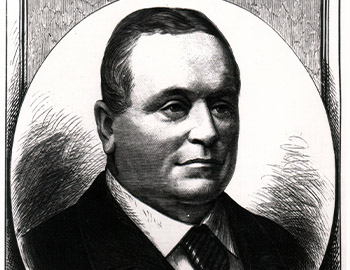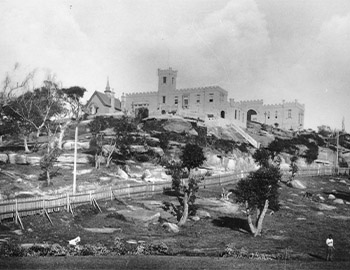We recently told the story of Fairlight House, one of the grandest homes in Manly that was demolished in 1939. That very same year, another grand home was also lost.
Picture this – One of the leading parliamentarians and barristers of New South Wales, atop Manly’s Constitution Hill in 1880. Overcome with inspiration from the panorama of Manly Cove and Sydney Harbour, decides to build a one of the grandest homes Manly ever saw.

William Bede Dalley QC, MLC, purchased a 0.4 hectare parcel of land known as Manly Heights and in 1882-83, began building his vision of Marinella (home by the sea). It was a Gothic Revival castle, like those in his Irish ancestral homeland.
By 1884 Dalley, by then the NSW Attorney-General, was occupying his grand home.
Dalley and his life in Marinella
Being a close associate of Henry Parkes, Edmund Barton and friend of Australia’s first appointed Cardinal, Cardinal Moran, Dalley must have relished the thought of two Catholic ‘castles’ dominating the Manly skyline: St Patrick’s College on the eastern hill and his own castle to the west. It was a "handsome structure of stone" as the Sydney Morning Herald once described, which had a "conservatory (tiled), hall, 8 rooms, 2 bathrooms, 2 storerooms, pantry, broom cupboard, kitchen and scullery with 3 rooms over" (Sydney Morning Herald, 28 August 1926). Grand dinners were held twice a week at Marinella which were attended by the leading political, artistic and literary people of that time
Dalley’s most politically active years were had while he was living in Marinella. He was appointed acting Colonial Secretary in October 1884, a position he held until May 1885 and as Acting Premier of NSW, approved and helped sponsor the contingent of 900 troops sent to Sudan in 1885.
By 1888, his health began to fail him and unfortunately passed away on 28 October 1888 from cardiac disease.

What happened to Marinella?
After Dalley’s death, Marinella was auctioned on 31 October 1889. It subsequently became a boarding-house and then eventually became derelict.
The property was then purchased by wealthy grazier William McGaw and remained in his family’s possession until the 1930s, before being passed on to their nephews. William McGaw did attempt to sell in 1926, with the Castle advertised as:
“One of the finest sites in this attractive seaside suburb, commanding views of the harbour and ocean and within view of the steamer wharf...This desirable property, with its spacious area, in the centre of Manly, should appeal to country residents as a town house, handy to the great surf bathing centre at the South Steyne, Manly Beach, and within a pleasant run of the city by boat or tram." (Sydney Morning Herald, 28 August 1926).
It did not appear to attract a buyer and the castle remained in a state of disrepair.
At a Manly Council meeting on 5 October 1926, a petition was presented by the community, requesting a public meeting for the purpose of considering what steps could be taken to secure Dalley’s Castle. In those depression years, Council commandeered Dalley’s Castle to provide shelter for homeless families while local children delighted in exploring the “haunted castle”. Camden Grammar School for boys then rented the premises from 1933 to 1939.
Another grand home lost
After towering over Manly for 60 years, Dalley’s Castle was demolished in 1939.
New laws to restrict residential flat buildings which were introduced the following year, were too late to save the famous landmark. There was strong local opposition to the destruction of Marinella including the Sydney Morning Herald who called for the “Control of Flats”, denouncing the “irretrievable damage” caused by the destruction of “romantic homes” like Dalley’s Castle.
The famous landmark was replaced by Housing Commission flats named Marinella and an original section of wall, complete with gargoyles, still stands above Sydney Road today.
If you would like further information, you can visit History Hub or contact our Local Studies Team.

